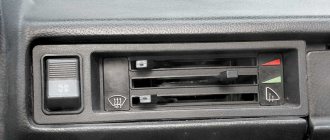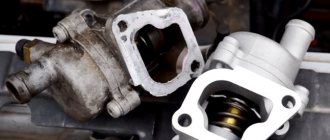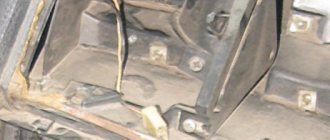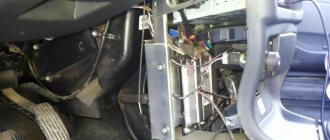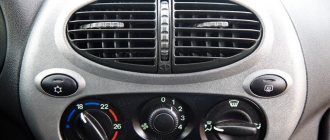Interior ventilation on a VAZ of the tenth family is supply and exhaust: air is supplied into the cabin through holes in the windshield trim (spontaneously - when the car is moving, or forced - when the heater fan is operating) and exits through the cracks between the upholstery and the inner door panels and beyond through the holes in the ends of the doors. These holes have valves that allow air to come out, but prevent it from getting inside the car. This design improves the thermal insulation of the cabin.
Heater air ducts and controls: 1 — heating air ducts for the rear part of the cabin; 2 — floor tunnel lining; 3 — air ducts for heating legs; 4 — central cabin ventilation nozzles; 5 — side nozzles for interior ventilation; 6 — nozzles for heating the windows of the front doors; 7 — control lever for the interior heating system; 8 — air distributor housing; 9 — foot heating damper; 10 — windshield heating flap; 11 - heater.
Heater damper VAZ 2110: causes of malfunctions and repairs
On the VAZ of the tenth family, which includes the VAZ 2110-2112 models, the designers used an electronically controlled internal heating system, thanks to which the temperature set by the driver is maintained automatically.
On the VAZ-2110, instead of a manual heater control mechanism with a cable drive, the main elements are: a coolant supply shut-off valve and dampers, an automatic heater control system (AHC) controller with a temperature sensor and gear motors that regulate the position of the blinds.
This type of furnace no longer uses an antifreeze shut-off valve, and the heater operating mode - “heating” or “ventilation” - is controlled by a central damper, which directs the air flow through the radiator or bypassing it.
When to change the radiator?
A heater radiator leak is an indisputable failure; it is immediately noticeable, if not by traces of antifreeze under the car, then by a drop in the liquid level in the expansion tank.
It is much more difficult when there seem to be no leaks, but at the same time, the radiator does not heat even at a high antifreeze temperature. In this case, the reason for the drop in heater temperature may be either a clogged or coked radiator, or a number of other reasons:
- air lock in the cooling system;
- non-working thermostat;
- breakdown in the hot air distribution system;
- air leakage through leaks in air ducts (this is a proprietary disease of the entire tenth family);
- low level of antifreeze in the expansion tank.
Antifreeze leaks under the radiator are a clear reason to look for a leak.
Heating system diagnostics
In short, before buying a new radiator or removing an old copper one for repair, you need to check the entire cooling system in detail so as not to throw money away.
By the way, about money and wind - at the service station they will ask for at least 2 thousand rubles to replace the heater radiator. Therefore, it is cheaper to do all the work of replacing the heater core yourself.
How the stove works on a VAZ 2110
Problems in the operation of the heating system on the VAZ "Ten" arise quite often. For this reason, owners of this car from the domestic automobile industry need to devote a lot of time to solving the problem or contact service center specialists for help and payment for repairs.
To understand how to repair a VAZ 2110 heater and carry out preventive measures, you must first think about what parts it is made of.
In addition, this unit includes many other components - valves, fittings and other elements combined into one unit. The unit is enclosed in a housing and placed under the hood near the dashboard.
troubleshooting
If problems occur with the stove, first you need to determine what exactly caused the heater to fail to operate normally.
| Cause | Your actions |
| Low antifreeze level | If the antifreeze in the system becomes less than necessary, the coolant circulation in the engine-radiator circuit stops. Try topping it up as over time there is less of it in the tank. If this doesn't help, look further for reasons. |
| Airlock | It can form when adding antifreeze to the system. To clear the traffic jam, you need to slightly raise the front of your car and run the engine at idle speed for 10 minutes. If air was indeed present in the system, the plug will go away and all that remains is to add coolant |
| Switch | The fan rotates at a speed set by the step controller. If you can turn on the stove only at maximum fan speed, and the electric motor device does not work in other modes, then the most likely reason is the stove resistor. It should be replaced with a new one |
| At maximum speed the flow is weak | The reason may be the system of closing and opening the damper, that is, the tap. But most often, this problem results from contamination of the cabin filter. This can be determined by the musty smell of dampness. Replace the filter and the problem may go away |
| There is a leak | This is the most popular type of breakdown associated with the heating system on the VAZ 2110. Leaks can occur through the stove and faucet. The crane is a very vulnerable spot for dozens of all VAZ models. When they first started producing the ten, the crane was being installed. Then it was removed from the structure, and after some time it was modified and returned |
| Antifreeze puddle in the cabin | If you notice a puddle of coolant under the feet of the front passenger, and also smell an unpleasant odor, then you should check the radiator and tap. Plus, be sure to study the current condition of the pipes in the places where they are attached with clamps |
The pipes on the VAZ 2110 have a limited service life. After about 3 years, they will begin to tan, which will certainly lead to the need to replace them. It is better to prevent leakage by replacing the stove pipes a little earlier than scheduled.
VAZ 2110 stove, heater, fan, dampers, video of replacing the VAZ 2110 stove radiator
The VAZ 2110 stove is perhaps the most problematic and capricious mechanism in the entire car design. A VAZ 2110 cannot be avoided without a faulty internal heater of the stove or radiator, given our cold climate. If in the summer a non-working stove may not bother you, then with the onset of cold weather it often turns out that the stove on the VAZ-2110 blows cold air. Today we will try to tell you in detail about the design, repair and replacement of heating elements in the “top ten”. For clarity, we will supplement the text with photos and videos.
Let’s say right away that the design of the heating system in the “ten” is fundamentally different from what was on the old VAZ models. The most important feature and difference of the internal heater is that the radiator of the VAZ 2110 heater and its fan are located not in the passenger compartment, but in the engine compartment. This design has its advantages, for example, to replace a heating radiator or stove fan, you do not need to completely disassemble the front panel (instrument panel).
Another important difference is the electronic control of climate processes in the cabin. To do this, the VAZ 2110 is equipped with a so-called automatic heater control system (AHC). Photo of the SAUO block below.
By the way, the SAUO unit on the “ten” of several years of production is different. Since 1996, 4 types of SAUO controllers have been produced. This should be taken into account when purchasing the unit as a spare part. It is this device that controls the temperature in the cabin and the operation of the fan. The temperature can be set from 16 to 28 degrees.
But how does this miracle device work? On the ceiling of the Dozen cabin there is a temperature sensor or ceiling air sensor with a built-in (very small) fan for air circulation. It is this sensor that sends information about the actual temperature in the cabin, and the SAUO unit gives a command to the micromotor gearbox (MMP), which, in turn, opens or closes the main damper, which is responsible for the access of hot air to the cabin. When the temperature in the cabin changes, the ceiling sensor sends a new signal, the micromotor-gearbox is activated by turning the damper, closing or opening the access of hot air into the cabin. Thus, the set temperature regime is maintained automatically. Also photo of the VAZ 2110 heater air duct diagram.
Checking components
Naturally, disassembling the stove on a VAZ 2110 and checking its components is necessary if you are dissatisfied with its operation, and also if it cannot be adjusted.
So:
The first thing to do is check to see if the fuse has blown. And although, if this happens, the thought immediately arises - change the blown fuse, do not rush. This is unlikely to immediately solve the problem; most likely, it is not the cause, but a consequence of some kind of failure that needs to be found; First of all, you need to check whether the damper moves when the parameters of the heater sensor change
Carefully, so as not to break the wire going to the backlight, remove the deflectors. Now you can clearly see whether the damper is turning or not
If you need to replace the heater damper, then installing an aluminum one instead of a plastic one will be justified; Check the resistance of the temperature sensor. If the temperature in the cabin is 16°C, then its resistance should be 250 Ohms, at 22°C - about 200 Ohms. If this is not the case, then installing a new sensor should help; It is also advisable to check the controller: remove it from the socket, turn on the ignition and, using the handle to change the temperature parameters, measure the voltage on the long connector. If the voltage does not change, then it is faulty; To check the gear motor of the stove, you will have to do a little disassembly: remove the frill, get to the drive of the gear motor (brown and pink wires are connected to it). Apply current from the battery to the connector. If it spins, it means it’s working, if not, you may need to install a new one; If the heater only operates in one position, the additional resistance (resistor) through which the fan is connected may have burned out. Installation of a new one is possible only from the engine compartment; Check if the wires in the controller are burnt out. To do this, it needs to be disassembled; On the right under the hood you will find the relay box. It is very possible that a wire has come loose from the relay responsible for operating the heater. At the same time, check the relay that turns on the heated rear window. If you do not have such heating, when tuning the stove, you can include this relay in the system; If the air entering the VAZ 2110 interior does not warm up sufficiently, be sure to check the antifreeze level, as well as the absence of its leakage from the heater;
Connecting the VAZ 2110 stove - Do-it-yourself car repair
Car heating systems often fail in winter. During this period, the stove is used much more often, which means that all the weak points of this device appear. The control unit for the VAZ-2110 stove often fails, as do other elements of the system. Today we will pay special attention to this node.
Design of the heating system VAZ-2110
It includes three main nodes. This is a control unit for the VAZ-2110 stove, an air duct system, and a heating unit. The oven is controlled by an electronic unit. It consists of knobs with which the driver sets the desired temperature and fan intensity. The unit also includes a temperature sensor.
As for the latter, it is necessary to automatically start the stove when the temperature inside the car drops more than two degrees below the set one. The sensor is equipped with a small fan. If you move the control knob to position A, a small electric motor in the heating block will start, which operates the damper.
The temperature sensor itself in the VAZ-2110 is located on the ceiling, near the lighting lamp.
Another important element of the heating system is air ducts. They are launched directly from the furnace itself, and each channel performs its own separate function. Therefore, the central channels are designed for internal ventilation.
The air distributor is responsible for supplying fresh air to the cabin for ventilation or hot air for heating. The other two air ducts are designed to heat the rear passenger compartment. The rest is also intended for ventilation. Two side channels heat the mirrors and part of the interior. Separate nozzles are used to heat the driver's feet.
Block responsible for temperature
The central unit of the stove system is the heating block, the function of which is to directly heat the interior. This block is organized as follows. An electric motor with fan blades pumps hot air, three dampers perform the function of recirculation and closing / opening of channels. There is also a radiator.
In modern new generation systems, heat exchangers do not have a valve. Therefore, the radiator is always hot, regardless of the time of year. The manufacturer claims that this solved the problem with the constant leakage of the faucet. In addition, heating of the interior is significantly faster. In summer, the supply ventilation comes out of the radiator.
Typical faults
In summer, problems with the stove are very difficult to detect. Practically not used for its intended purpose. With the onset of winter, the question of the efficiency of the heating system becomes more pressing. Let's look at the typical faults that VAZ-2110 owners most often encounter. In case of serious problems, only replacing the VAZ-2110 stove can be an effective solution.
If the mechanism is not working efficiently, the first thing you need to do is check the amount of coolant. They look at the expansion tank - there are warning signs and a system lock indicator on it. If there is not enough liquid, add more. Sometimes even after topping up, the coolant level drops. This may indicate leaks.
Modernization of the damper on the VAZ-2110
Malfunctions with the damper often result in the interior heating very poorly and slowly. The error is the VAZ-2110 heater control unit. The controller is not working properly. The device does not issue a command to extend the flap. In this case, it is recommended to check the temperature sensor.
The controller handle is set to its extreme position and then unscrewed several times from left to right. The air flow temperature must be adjusted manually. In this way, the operating condition of the sensor is checked in one of the extreme positions of the handle.
If the air flow changes the temperature in the extreme position of the knob, the sensor must be replaced. If warming does not change, the cause must be looked elsewhere.
Important subtleties
- When installing a plastic flap, sometimes you have to grind and adjust the flap into place so that it moves freely. It is also allowed to do a little extra work near the aluminum damper.
- After installing the damper, you should set it by hand to the cold air supply position. In this position, the heater radiator will be covered with a damper.
- Move the temperature sensor to the MIN position and turn on the ignition. The sensor will begin to rotate and take the correct position. This will make it easier for you to insert it into place, since the damper and gearbox will be in the MIN position.
- Buy a double for the washer hose, as this will simplify the installation and removal of the wind cover in the future.
As you can see, there is nothing difficult in removing the heater core if you know what to do.
Video:
Video:
How the VAZ-2112 stove works
Driver comfort is largely determined by the normal operation of the stove. In VAZs, it is this system that most often fails, and in order to quickly solve the problem, you need to become familiar with the design of the stove, understand its circuit and have a good understanding of the principle of operation. In this article we will talk about the heating system of the VAZ-2112.
Driving comfort in winter depends on proper operation of the stove
How the oven works
VAZ 2110 models of the first years of production are equipped with an old-fashioned stove.
You should know that the design of the old-fashioned VAZ 2110 stove does not differ significantly from the new version, regardless of the power unit used, with the exception of a few points that will be discussed below:
- even micro gearboxes are different. Older elements have slightly different resistors. Therefore, before starting repair work, make sure that the appliances are truly interchangeable, and that you purchased old heating elements for the old version of the oven, and not new ones. Otherwise, difficulties will arise with the functioning of this element.
- radiator design. The main difference between ovens is this. So, if you intend to install a new radiator instead of an outdated version, then you need to take into account some installation nuances;
- The controller handle on the devices is slightly different. Old technology has a serious drawback: it is no longer produced. For this reason, position controls 4 and 5 manufactured before 2004 are not suitable for a new oven;
How to fix a stove
As already mentioned, the heating systems on VAZ 2110 models are practically no different from each other in design. And it doesn’t matter which engine is under the hood: carburetor or injection.
So the repair manual described below can be used by all owners of “dozens” of VAZs.”
If you are planning a major overhaul of a stove manufactured before 2003, we recommend purchasing a radiator first. A copper element is more suitable as it is more efficient and allows the stove to perform better.
The procedure for repairing a stove fan
- Disassemble the heater motor. First remove the impeller, then the spring clips.
- Deprive him of support.
- Remove the brush assembly by unscrewing the screws first.
- Carefully knock out the rotor.
- Remove dust and dirt from all elements of the heater motor.
- Release the bearing by bending the edges of the plate on the inside of the stator.
- Remove the old bearing #609 and install the new one.
- Fold back the edges of the plate.
- Assess the condition of the plate after this procedure and sand the edges if necessary.
- Remove the old brushes along with the wires. In their place, solder the wires from the new brushes.
- Bend the brush spring stops to easily return the brush assembly to its place. Set it aside.
- Replace the heater motor rotor.
- Reinstall the brush assembly, making sure that the brushes are in their rightful places.
- Fill the gaps with springs and return the stops to their original position.
- Reinstall the impeller.
- Reconnect the electric motor to the stove network.
Problem solving
Now let's talk about how to troubleshoot problems that arise, troubleshoot problems, and return the heater to normal operation.
Each breakdown requires separate consideration.
Temperature not regulated
If it is not possible to regulate the temperature of the air flow, the problem lies in the control unit or damper, or the temperature sensor on the ceiling inside the cabin does not work.
To check, turn the control all the way to the right and place your hand under the air stream. If hot air only flows when the control is in the maximum heating position, replace the sensor. If this does not help, replace the regulator. When heat is transferred to other places on the controller, the sensor should not be at fault.
Be sure to check that the shock is not blocked. You can get to it through the engine compartment. If replacement is required, replace the standard plastic curtain with an aluminum one. It's more durable.
Blowing cold
If the heater on your VAZ 2110 starts blowing cold air, then you need to look for the reasons. The reason for the failure lies in the gear motor. A similar situation occurs in 9 out of 10 cases, so it is unlikely that you will have to look for alternative culprits.
The gear motor must be replaced. This is done as follows:
- The fringe and windshield wipers are back in place. Job is done.
- Wipers removed;
- Unscrew the three screws holding the gear motor;
- The ruffle is dismantled;
- Disconnect the wiring;
- A new one is installed in place of the failed device. Ask an assistant to change the position modes of the regulator and at this time you will install the gear motor;
But there is 1 case out of 10 that will force you to change the heater due to wear and tear of the old one. As the practice of VAZ 2110 owners shows, the heater from 2112 is more suitable for replacement. In addition, you can choose between two stove options: 2112-01 or 2112-02. The first option is without an air filter, and the second option is without it.
The windows fog up, the feet are not heated
VAZ models often have a problem when the air comes out of the stove normally, but does not warm the feet and does not go into the glass.
The problem can be solved by updating the air ducts and eliminating existing cracks in the cabin and hot air ducts. This is a rather complicated procedure, the implementation of which will allow you to forget for a long time about the problem with the stove, which does not heat the legs and does not blow up the side windows.
It would not be superfluous to mount a pre-heater. Due to this, the interior heats up faster.
Components and processes of the VAZ-2112 heater
- resistor;
- electro-pneumatic valve;
- damper on the stove channel;
- recirculation flap control valve;
- radiator and its casing;
- stove control damper;
- water-reflecting air intake deflector;
- fittings for steam outlet and supply pipelines;
- cover from the stove lining.
- casing from the air intake of the heating system, consisting of front and rear parts;
- micromotor-gearbox with damper control;
- stove motor in the housing and fan;
- support platform for the heater control hatch activation lever and the lever itself;
- recirculation deflector on the air intake;
The radiator is located horizontally under the instrument panel. It is enclosed in a plastic case. The radiator design includes two plastic tanks and a pair of aluminum tubes on which plates are molded. There is a steam outlet on the left side of the tank. The passage of intake air through the radiator depends on the position of the dampers. If the shock absorbers are in the extreme position, all the air flow may pass through the radiator or not at all.
Lack of tap - plus or minus?
While older VAZ models have a tap that can be used to shut off the supply of antifreeze to the radiator, the VAZ-2112 is not equipped with such an element. If the engine is running, the radiator heats up regardless of the time of year. This design feature of the stove makes it possible to achieve a small inertia, which is inherent in the system when starting up. In other words, the required temperature will be reached in a shorter time. Additionally, the user will not have to deal with leaks that occur as a result of a leaking faucet. The electronic control unit, which generates the necessary commands, is responsible for the ability to conveniently control the operation of the stove.
Diagnosis of recirculation system malfunctions
If outside air continues to flow when the button is pressed, there is a problem with the system. You can determine the cause of the breakdown by diagnosing the cooling system, which involves performing the following actions:
- turning on the ignition, starting the power unit;
- setting the maximum fan speed mode;
- pressing the recirculation key.
This triggers the valve and closes the damper. If the car is moving at a constant speed and the damper is completely closed for several seconds, the system is working properly. If there are suspicious sounds (clicks, pops) and the damper moves jerkily, we can talk about problems.
Description of the heating system on "Dvenashka"
In VAZ 2112 cars, supply and exhaust ventilation is used. In this case, the air flow enters through special holes that are located in the windshield lining. The air itself can be supplied forcefully, under the influence of a heater fan, or arbitrarily. Air flows out of the cabin through gaps located between the door panels, as well as at their ends. Special valves are built into these openings that allow air to escape and also delay its entry, improving the thermal insulation of the cabin.
Design Features
The VAZ 2110 provides for the installation of two types of stoves - a new model and an old one. Regardless of the engine used (injection or carburetor), there are no fundamental differences in the design of the stove.
But what is the difference between new and old stoves? Let's try to figure it out.
- Since September 2003, several micromotor gearboxes have been installed in the furnaces. The difference lies in the shaft position sensors (resistances). Therefore, when repairing, make sure that the devices are truly interchangeable and that you purchased old-fashioned resistors for your old stove, and not a new one. Otherwise, the gear motor will not work.
- Radiator design. This is the main difference between the devices. Therefore, when replacing a radiator from an old one to a new one, be sure to take into account the installation nuances;
- The controller knob on the plates is slightly different. There's a big problem with old-fashioned heaters: They're out of production. They cannot be analogues of 4- and 5-position regulators, which began to be supplied in dozens in the fall of 2003;
Heating device design
The heating of the VAZ-2110, thanks to which a motorist can feel comfortable in his mobile property at any time of the year, consists of several separate devices that work in close contact. The central device of the unit is the radiator, with the help of which the air flows entering the cabin are heated. In order to repair or replace the radiator, you will have to look for ways to get under the hood.
The second most important device can be called an air distributor, in which several nozzles operate in the “ten” of the cabin. Compared to the old-fashioned models that preceded the release of the VAZ-2110, the new car has an evaporator that has found a place in the air conditioning system.
The operation of the stove is controlled by a special control unit. In the VAZ-2110 operating instructions, this device has a different name (controller). The unit works in conjunction with a temperature sensor located in the cabin. The sensor transmits temperature information to the unit, after which the data is compared (the information displayed on the handle is taken into account). As soon as the system detects a temperature difference of 2°, hot or cooled air is immediately supplied to the cabin.
To understand how the heating element works, you need to pay attention to the handle of the device; Two extreme positions deserve special attention: MAX and MIN. The fact is that when you set the knob to one of these indicators, the system begins to give off heat, not taking into account the data from the temperature sensor.
The VAZ-2110 stove includes a device such as a gear motor. The task of this device is to open and close the damper. The small electric motor is extremely important in the operation of the heater. Even with a minor malfunction of the gear motor, the system will be able to supply the car owner with either only cold or only hot air. If this device fails when the damper is closed, the entire system will cease to perform its function. Main components of the heating device:
- gear motor.
- radiator;
- SUAO block;
- ceiling sensor;
- lever arm;
- a device that distributes air flows;
- shock absorber;
Purpose of the radiator
The VAZ-2110 stove of the new model has a radiator through which the air entering the car is heated. Quite often on the global network you can find diagrams in which the radiator is designated as a heat exchanger. The heating process in the device occurs due to the flow of hot antifreeze. The radiator is connected to the cooling system of the power unit through several pipes and hoses. The refrigerant circulates continuously inside the heat exchanger. The position of the damper determines the volume of incoming air and its direction. When the heater damper is in an intermediate position, part of the air passes through the heat exchanger, and the remaining volume bypasses the radiator. The diagram shows that the new radiator design differs from other models in several useful improvements.
What is a thermostat?
The thermostat itself is an important part in the engine cooling system. It is designed to ensure that the engine is cooled according to its needs. For example, you start the engine “cold”, then at 80 to 90 degrees a large circle opens and liquid enters the radiator and begins to cool the engine more intensively than in a small circle .
For example, you started the engine “cold”, then at degrees from 80 to 90 a large circle opens and liquid enters the radiator and begins to cool the engine more intensively than in a small circle.
The thermostat itself consists of:
- Frame.
- Internal compartment.
- 2 pipes with valves.
- "Core". Thermoelement (copper powders, a mixture of granulated wax, graphite and aluminum in a special proportion).
- Valves.
How to identify a breakdown?
The engine begins to overheat or does not reach operating temperature - these are the main two criteria for a faulty thermostat.
But there are also auxiliary signs: there is no heat in the cabin when it gets cold, a decrease in dynamic performance (power, speed), increased fuel consumption (about the passport consumption standards here).
